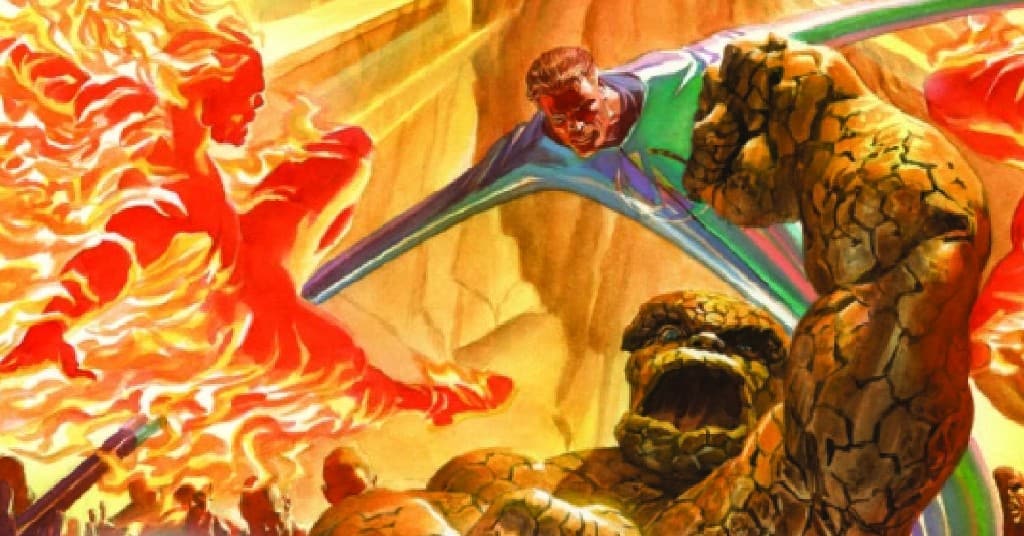Fantastic Four #9
Recap
Alicia, Sue and Johnny face off against Ben and Reed - as they battle for the survival of their minds themselves against an alien that can wipe their memories clean! But can they survive this brutal onslaught from their friends and lovers, the very people who know them - and their powers - better than anyone else in the universe? We'll all find out together in this Alicia-narrated issue! Plus: A meditation on the nature of art itself! And cool fights too!
Review
Fantastic Four #9 opens with a framing device that sets up the slightly meta nature of the issue. Alicia explains how she is able to enjoy comics with Ben’s assistance. After two pages devoted to that, the issue snaps back to the huge melee between Reed and Ben and the makeshift Fantastic Four. The fight takes up the bulk of the issue (with a one-page interlude delivering Xargorr’s backstory). The team doesn’t have an answer for how to turn everyone back from Xargorr’s memory manipulation, but even so, they do hold their own. That is, until Xargorr turns Johnny and the fight gets far more desperate.
Telling a story from Alicia’s point of view is a novel concept. Effectively conveying Alicia’s experience, though, is a whole other matter. Fantastic Four #9 is a meta experience as Alicia breaks the fourth wall to the extent that she knows she’s narrating events within a comic book–a medium that she can’t experience on her own because of the visual element. She goes on to discuss how comics work as a medium and how the imagination essentially fills in the blanks between the still images. The reader’s brain creates the story, something that applies even more in Alicia’s case. The creative team can’t write a comic that gives us Alicia’s actual sensory experience, but they can at least explain how it would be for Alicia.
Fantastic Four #9 uses multiple visual devices to convey Alicia’s point of view. As the body of the story unfolds, it is presented entirely with panels in haphazard layouts and uneven shapes. This contrasts with the few places where Alicia is narrating established backstory which is laid out in ordinary, evenly laid out panels. It’s an effective way to show how comfortable Alicia is envisioning and understanding more established situations as opposed to functioning in a very chaotic battle in the present.
The most interesting moment in the issue comes about halfway through as Alicia, Sue, and Johnny try to regroup against Ben and Reed. Alicia comes up with a new plan and the sequence where she does this happens on a page of exclusively black panels. North writes Alicia describing what she wants as well as having her narrate what her other senses are telling her about the situation in lieu of her being able to see it.
At the heart of Fantastic Four #9 is the question of what makes a person’s identity. Xargorr says that people are nothing more than the sum of their memories and argues (albeit in a very self-serving fashion) that her manipulation actually improves everyone. For instance, when they forget about people or events they don’t like, they stop hating. Alicia takes the opposite viewpoint–that there is an intrinsic good to all humans and that even robbed of their memories, that will always remain.
Visually, Fantastic Four #9 is a rich and exciting comic. Fiorelli draws very dynamic action. But it’s Aburtov who takes the cake with the way he presents Sue’s forcefields–translucent without ever being transparent. He also uses a darker blue on the more rigid constructs compared with a softer, whiter look to the more fluid ones. And a two-page spread featuring Johnny and Sue with their abilities dialed up to eleven is a showcase for both Fiorelli and Aburtov.
Caramagna does a very good job of keeping a clean flow to the dialogue and heavy narration in this issue. This is especially useful given the somewhat more chaotic panel layouts. The caption boxes never feel in the way, which is quite the feat in some cases.
Final Thoughts
Fantastic Four #9 is the most ambitious issue yet in what it tries to do with Alicia’s viewpoint. The fourth wall breaking opening narration is a clever way to begin. The constantly haphazard panel layouts are creative. The blacked out page is a fantastic choice. But ultimately there is only so much a visual medium can do to convey the experience of a sightless character. While the creative team deserves credit for trying something as novel as this, they don’t quite stick the landing.
Fantastic Four #9: A New Point of View
- Writing - 8/108/10
- Storyline - 8.5/108.5/10
- Art - 9.5/109.5/10
- Color - 10/1010/10
- Cover Art - 9/109/10
